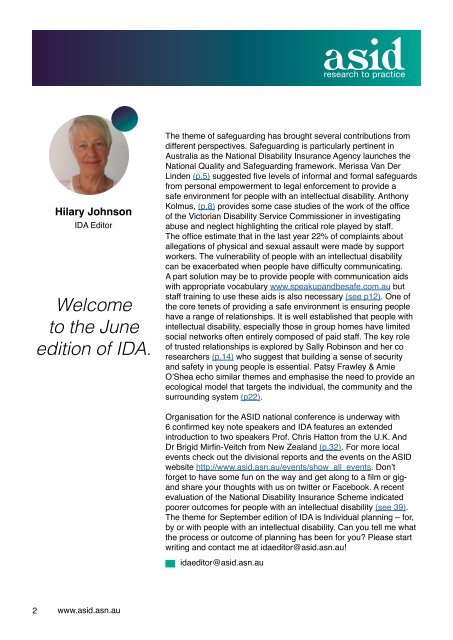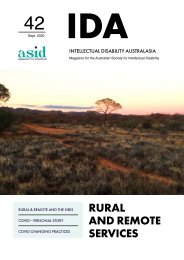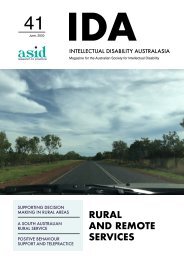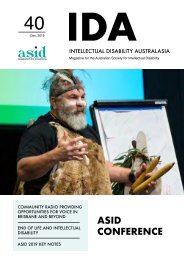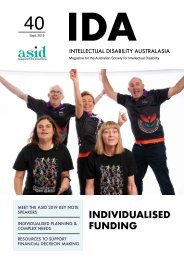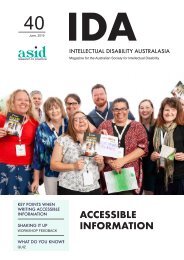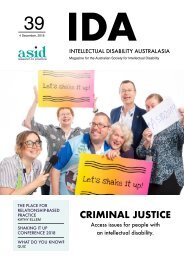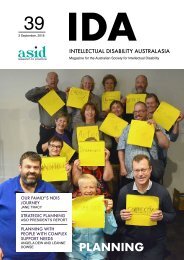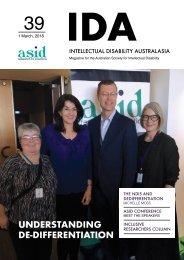Create successful ePaper yourself
Turn your PDF publications into a flip-book with our unique Google optimized e-Paper software.
Hilary Johnson<br />
<strong>IDA</strong> Editor<br />
Welcome<br />
to the <strong>Jun</strong>e<br />
edition of <strong>IDA</strong>.<br />
The theme of safeguarding has brought several contributions from<br />
different perspectives. Safeguarding is particularly pertinent in<br />
Australia as the National Disability Insurance Agency launches the<br />
National Quality and Safeguarding framework. Merissa Van Der<br />
Linden (p.5) suggested five levels of informal and formal safeguards<br />
from personal empowerment to legal enforcement to provide a<br />
safe environment for people with an intellectual disability. Anthony<br />
Kolmus, (p.8) provides some case studies of the work of the office<br />
of the Victorian Disability Service Commissioner in investigating<br />
abuse and neglect highlighting the critical role played by staff.<br />
The office estimate that in the last year 22% of complaints about<br />
allegations of physical and sexual assault were made by support<br />
workers. The vulnerability of people with an intellectual disability<br />
can be exacerbated when people have difficulty communicating.<br />
A part solution may be to provide people with communication aids<br />
with appropriate vocabulary www.speakupandbesafe.com.au but<br />
staff training to use these aids is also necessary (see p12). One of<br />
the core tenets of providing a safe environment is ensuring people<br />
have a range of relationships. It is well established that people with<br />
intellectual disability, especially those in group homes have limited<br />
social networks often entirely composed of paid staff. The key role<br />
of trusted relationships is explored by Sally Robinson and her co<br />
researchers (p.14) who suggest that building a sense of security<br />
and safety in young people is essential. Patsy Frawley & Amie<br />
O’Shea echo similar themes and emphasise the need to provide an<br />
ecological model that targets the individual, the community and the<br />
surrounding system (p22).<br />
Organisation for the ASID national conference is underway with<br />
6 confirmed key note speakers and <strong>IDA</strong> features an extended<br />
introduction to two speakers Prof. Chris Hatton from the U.K. And<br />
Dr Brigid Mirfin-Veitch from New Zealand (p.32). For more local<br />
events check out the divisional reports and the events on the ASID<br />
website http://www.asid.asn.au/events/show_all_events. Don’t<br />
forget to have some fun on the way and get along to a film or gigand<br />
share your thoughts with us on twitter or Facebook. A recent<br />
evaluation of the National Disability Insurance Scheme indicated<br />
poorer outcomes for people with an intellectual disability (see <strong>39</strong>).<br />
The theme for September edition of <strong>IDA</strong> is Individual planning – for,<br />
by or with people with an intellectual disability. Can you tell me what<br />
the process or outcome of planning has been for you? Please start<br />
writing and contact me at idaeditor@asid.asn.au!<br />
idaeditor@asid.asn.au<br />
2 www.asid.asn.au


